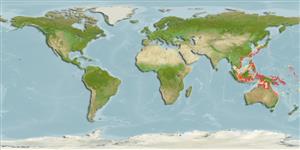Klassifizierung / Names
Namen | Synonyme | Catalog of Fishes(Gattung, Arten) | ITIS | CoL | WoRMS | Cloffa
>
Gobiiformes (Gobies) >
Gobiidae (Gobies) > Gobiinae
Etymology: Ancistrogobius: Name from Greek word 'agkistros' meaning fishhook and Gobius , a genus name of gobiine fish, in reference to the short, ventrally directed, spur-like preopercular spine; dipus: Name from Greek words 'dis' meaning two and 'pous' for foot. referring to its largely separated pelvic fins.
Environment: milieu / climate zone / depth range / distribution range
Ökologie
seewasser benthopelagisch; tiefenbereich 15 - 35 m (Ref. 84001). Subtropical
Verbreitung
Länder | FAO Gebiete | Ecosystems | Vorkommen | Point map | Einführungen | Faunafri
Western Pacific: Japan to the Great Barrier Reef.
Size / Gewicht / Alter
Maturity: Lm ? range ? - ? cm
Max length : 4.2 cm SL Männchen/unbestimmt; (Ref. 84001)
Kurzbeschreibung
Bestimmungsschlüssel | Morphologie | Morphometrie
Rückenflossenstacheln (insgesamt) : 7; Rückenflossenweichstrahlen (insgesamt) : 9 - 10; Afterflossenstacheln: 1; Afterflossenweichstrahlen: 9. This species is unique from its congeners by having the following characters: largely separated pelvic fin with rudimentary connecting membrane and no frenum; fifth segmented ray of pelvic fin short, length 67.9-71.9% of preceding ray; a narrow black blotch on distal tip of
first dorsal fin (not reaching posteriorly to third spine); pectoral-fin rays 19-21, usually 20; head and most of nape naked, no predorsal scales (except for one specimen, WAM-P.32537-001, with one predorsal scale); third spine of first dorsal fin greatly elongated, filamentous, obviously longer than preceding spine, typically with alternating pale and dusky (or yellow) bands when alive or fresh; faint, dusky blotches (not forming distinct vertical bar) below eye; sensory papilla x^1 and x^2 not continuous, interrupted by row trp; sensory papilla rows trp long, extending dorsally to well above a longitudinal line through row x^1; anterior tip of sensory papilla row b meeting row 4; sensory papilla row 4 long, dorsal tip close to eye; possess a relatively slender and pointed snout (this character difficult to quantify) (Ref. 84001).
Collected from sandy-mud or silt bottoms with dead-coral rubble at depths of 15-35 m (Ref. 84001).
Life cycle and mating behavior
Geschlechtsreife | Fortpflanzung | Ablaichen | Eier | Fecundity | Larven
Shibukawa, K., T. Yoshino and G.R. Allen, 2010. Ancistrogobius, a new cheek-spine goby genus from the West Pacific and Red Sea, with descriptions of four new species (Perciformes: Gobiidae: Gobiinae). Bull. Natl. Mus. Nat. Sci., Ser. A, (Suppl. 4):67-87. (Ref. 84001)
IUCN Rote Liste Status (Ref. 130435: Version 2024-1)
Bedrohung für Menschen
Harmless
Nutzung durch Menschen
Tools
Zusatzinformationen
Download XML
Internet Quellen
Estimates based on models
Preferred temperature (Ref.
123201): 25 - 28.9, mean 27.9 °C (based on 96 cells).
Phylogenetic diversity index (Ref.
82804): PD
50 = 0.5625 [Uniqueness, from 0.5 = low to 2.0 = high].
Bayesian length-weight: a=0.00724 (0.00339 - 0.01546), b=3.10 (2.92 - 3.28), in cm total length, based on LWR estimates for this (Sub)family-body shape (Ref.
93245).
Trophic level (Ref.
69278): 3.2 ±0.3 se; based on size and trophs of closest relatives
Widerstandsfähigkeit (Ref.
120179): hoch, Verdopplung der Population dauert weniger als 15 Monate. (Preliminary K or Fecundity.).
Fishing Vulnerability (Ref.
59153): Low vulnerability (10 of 100).
